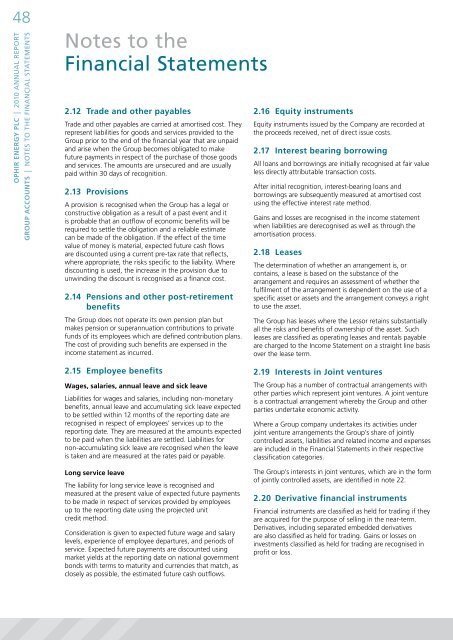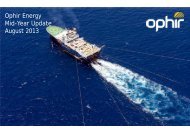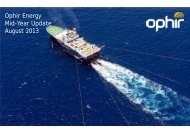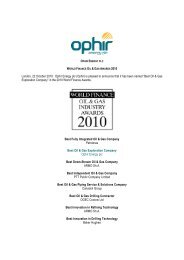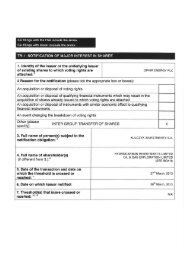Annual Report 2010 - Ophir Energy
Annual Report 2010 - Ophir Energy
Annual Report 2010 - Ophir Energy
You also want an ePaper? Increase the reach of your titles
YUMPU automatically turns print PDFs into web optimized ePapers that Google loves.
48<br />
<strong>Ophir</strong> energy plc | <strong>2010</strong> ANNUAL REPORT<br />
grOUp AccOUnTs | NOTEs TO THE fiNANCiAL sTATEmENTs<br />
Notes to the<br />
financial statements<br />
2.12 Trade and other payables<br />
Trade and other payables are carried at amortised cost. They<br />
represent liabilities for goods and services provided to the<br />
Group prior to the end of the financial year that are unpaid<br />
and arise when the Group becomes obligated to make<br />
future payments in respect of the purchase of those goods<br />
and services. The amounts are unsecured and are usually<br />
paid within 30 days of recognition.<br />
2.13 provisions<br />
A provision is recognised when the Group has a legal or<br />
constructive obligation as a result of a past event and it<br />
is probable that an outflow of economic benefits will be<br />
required to settle the obligation and a reliable estimate<br />
can be made of the obligation. If the effect of the time<br />
value of money is material, expected future cash flows<br />
are discounted using a current pre-tax rate that reflects,<br />
where appropriate, the risks specific to the liability. Where<br />
discounting is used, the increase in the provision due to<br />
unwinding the discount is recognised as a finance cost.<br />
2.14 pensions and other post-retirement<br />
benefits<br />
The Group does not operate its own pension plan but<br />
makes pension or superannuation contributions to private<br />
funds of its employees which are defined contribution plans.<br />
The cost of providing such benefits are expensed in the<br />
income statement as incurred.<br />
2.16 equity instruments<br />
Equity instruments issued by the Company are recorded at<br />
the proceeds received, net of direct issue costs.<br />
2.17 interest bearing borrowing<br />
All loans and borrowings are initially recognised at fair value<br />
less directly attributable transaction costs.<br />
After initial recognition, interest-bearing loans and<br />
borrowings are subsequently measured at amortised cost<br />
using the effective interest rate method.<br />
Gains and losses are recognised in the income statement<br />
when liabilities are derecognised as well as through the<br />
amortisation process.<br />
2.18 leases<br />
The determination of whether an arrangement is, or<br />
contains, a lease is based on the substance of the<br />
arrangement and requires an assessment of whether the<br />
fulfilment of the arrangement is dependent on the use of a<br />
specific asset or assets and the arrangement conveys a right<br />
to use the asset.<br />
The Group has leases where the Lessor retains substantially<br />
all the risks and benefits of ownership of the asset. Such<br />
leases are classified as operating leases and rentals payable<br />
are charged to the Income Statement on a straight line basis<br />
over the lease term.<br />
2.15 employee benefits<br />
wages, salaries, annual leave and sick leave<br />
Liabilities for wages and salaries, including non-monetary<br />
benefits, annual leave and accumulating sick leave expected<br />
to be settled within 12 months of the reporting date are<br />
recognised in respect of employees’ services up to the<br />
reporting date. They are measured at the amounts expected<br />
to be paid when the liabilities are settled. Liabilities for<br />
non-accumulating sick leave are recognised when the leave<br />
is taken and are measured at the rates paid or payable.<br />
long service leave<br />
The liability for long service leave is recognised and<br />
measured at the present value of expected future payments<br />
to be made in respect of services provided by employees<br />
up to the reporting date using the projected unit<br />
credit method.<br />
Consideration is given to expected future wage and salary<br />
levels, experience of employee departures, and periods of<br />
service. Expected future payments are discounted using<br />
market yields at the reporting date on national government<br />
bonds with terms to maturity and currencies that match, as<br />
closely as possible, the estimated future cash outflows.<br />
2.19 interests in Joint ventures<br />
The Group has a number of contractual arrangements with<br />
other parties which represent joint ventures. A joint venture<br />
is a contractual arrangement whereby the Group and other<br />
parties undertake economic activity.<br />
Where a Group company undertakes its activities under<br />
joint venture arrangements the Group’s share of jointly<br />
controlled assets, liabilities and related income and expenses<br />
are included in the Financial Statements in their respective<br />
classification categories.<br />
The Group’s interests in joint ventures, which are in the form<br />
of jointly controlled assets, are identified in note 22.<br />
2.20 Derivative financial instruments<br />
Financial instruments are classified as held for trading if they<br />
are acquired for the purpose of selling in the near-term.<br />
Derivatives, including separated embedded derivatives<br />
are also classified as held for trading. Gains or losses on<br />
investments classified as held for trading are recognised in<br />
profit or loss.


